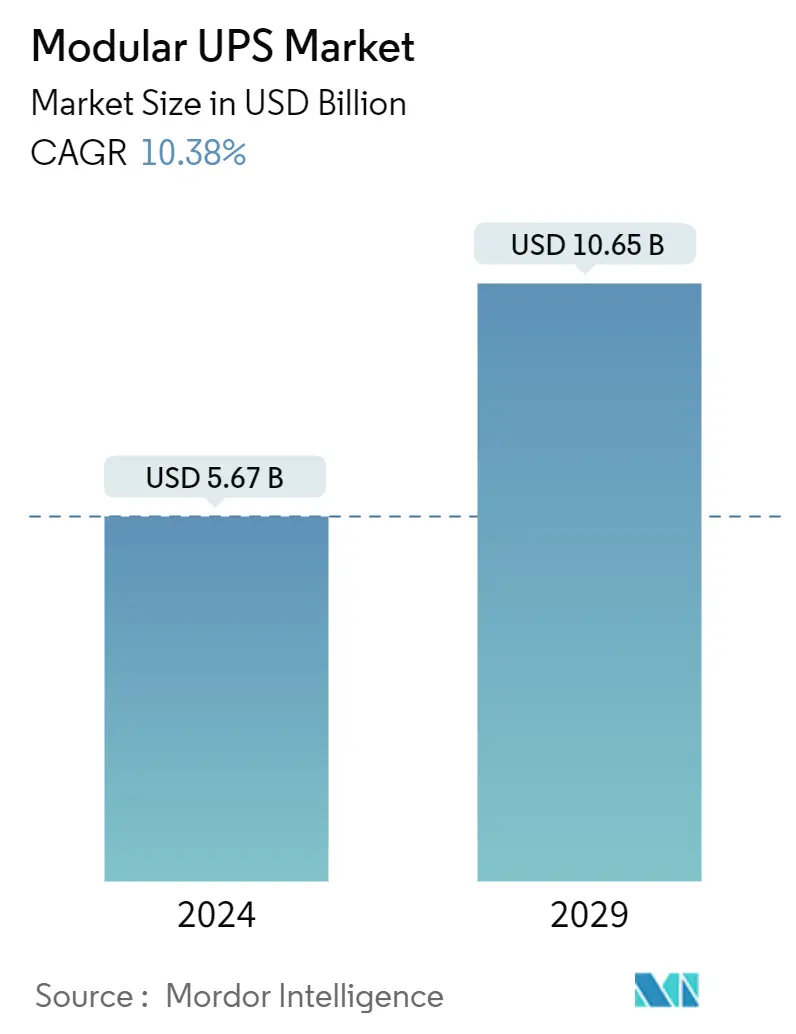Market Size of Modular UPS Industry

| Study Period | 2019-2029 |
| Market Size (2024) | USD 5.67 Billion |
| Market Size (2029) | USD 10.65 Billion |
| CAGR (2024 - 2029) | 10.38 % |
| Fastest Growing Market | Asia Pacific |
| Largest Market | North America |
| Market Concentration | Low |
Major Players
*Disclaimer: Major Players sorted in no particular order |
Modular UPS Market Analysis
The Modular UPS Market size is estimated at USD 5.67 billion in 2024, and is expected to reach USD 10.65 billion by 2029, growing at a CAGR of 10.38% during the forecast period (2024-2029).
Data losses, lack of key services, hardware risks and significant financial loss may result from power disturbances in data centers that typically require 100% availability. Therefore, in order to ensure continuous power supply and reduce the risk of system failure, there is a high demand for UPSs in data centers. As a result of the growing reliance on large-scale applications and cloud services, demand for colocation services has increased, offering new prospects for the modular UPS industry.
- The modular uninterruptible power supply (UPS) is a resilient and adaptable power protection system that regulates UPS performance. The modules are hot-swappable and automatically recognized when connected. The product's adoption is expected to be strengthened by its robust implementation of zero and dependable power downtime. Modular UPS systems are becoming more prevalent among companies that require a dependable power source for their essential infrastructure.
- There has been a growing demand for new technology advancements, such as cloud computing adoption, data storage needs,digital services, regulatory requirements, expanding user base, and business scalability across regions.
- The primary benefits of a modular uninterruptible power supply (UPS) system lie in its capacity for scalable expansion and decreased maintenance expenses. Hyperscale data centers and colocation providers employ modular UPS technology, employing various architectures to minimize operational costs and maintain redundant capacity. Many organizations opt for smaller modules supporting 10-kilovolt amperes to 50 kVA, as N+1 designs offer cost-effective redundancy, superior loading, and efficiency compared to multiple parallel UPS systems. Meanwhile, 2N designs ensure precise load matching.
- Modular systems offer a simplified and more manageable approach to maintenance. The modules are designed to be hot-swappable, allowing for seamless removal, replacement, and testing while the system remains operational. Modular UPS systems have power capacities ranging from 10-100 kVA, 100-250 kVA, 215 kVA, and 500 kVA and above. These systems are widely utilized in diverse sectors, including data centers, industries, telecommunications, commercial, BFSI, government, and other verticals.
- Moroever, the initial installation expenses associated with modular UPS systems typically exceed those of conventional centralized UPS solutions. Although the modular approach provides scalability and adaptability, the upfront capital investment may dissuade budget-conscious clients, particularly those in smaller enterprises or organizations with limited financial resources.
- The modular uninterruptible power supplyUPS market has been negatively affected by the COVID 19 pandemic. The development of the modular UPS market has been greatly influenced by the closure of large government, energy and industrial undertakings.
Modular UPS Industry Segmentation
A Modular UPS is an uninterrupted power supply system that is built from a combination of individual power modules that combines to form a larger system. Modular UPS can be scaled up or down to meet specific power requirements. Each module in a modular UPS works as a separate UPS and includes a rectifier, inverter, battery charger, bypass arrangement and back feed protection. These modules can be combined in parallel to increase capacity or in series to increase runtime.
The modular ups market is segmented by power capacities (10 - 100 kVA, 51 - 100 kVA, 101 – 300 kVA, and 301 and above kVA), end user (data centers, industrial, telecommunication, commercial, BFSI, government and infrastructure and other end users, and geography (North America (United States and Canada), Europe (United Kingdom, France, Germany, Italy, and Rest of Europe), Asia-Pacific (China, India, Japan, Rest of Asia-Pacific), Latin America and Middle East and Africa. The market sizes and forecasts are provided in terms of value (USD) for all the above segments.
| By Power Capacities | |
| 0 - 50 kVA | |
| 51 - 100 kVA | |
| 101 - 300 kVA | |
| 301- Above kVA |
| By End User | |
| Data Centers | |
| Industrial | |
| Telecommunication | |
| Commercial | |
| BFSI | |
| Government/Infrastructure | |
| Other End Users |
| By Geography | |||||||
| |||||||
| |||||||
| |||||||
| Latin America | |||||||
| Middle East & Africa |
Modular UPS Market Size Summary
The modular uninterruptible power supply (UPS) market is poised for significant growth, driven by the increasing demand for reliable power solutions in data centers and critical infrastructure. As businesses increasingly rely on cloud services and large-scale applications, the need for continuous power supply to prevent data loss and system failures has become paramount. Modular UPS systems, known for their scalability and reduced maintenance costs, are gaining traction across various sectors, including telecommunications, healthcare, and manufacturing. These systems offer the advantage of hot-swappable modules, ensuring minimal downtime and operational efficiency. Despite higher initial installation costs compared to traditional UPS solutions, the long-term benefits of scalability and adaptability make modular systems an attractive option for organizations seeking to enhance their power reliability.
The market landscape is characterized by a high degree of fragmentation, with numerous players such as ABB Ltd, Emerson Network Power, and Schneider Electric SE contributing to the competitive environment. North America leads the market due to its robust IT and telecommunications sectors, alongside a growing emphasis on data security and hybrid UPS solutions. Latin America is also witnessing increased adoption of modular UPS systems, fueled by advancements in technologies like IoT and AI. The COVID-19 pandemic has impacted market growth, but the ongoing digital transformation and the push towards a cashless economy, particularly in the financial sector, are expected to drive demand for modular UPS systems. Recent product launches, such as ABB's MegaFlex DPA UPS solutions and Schneider Electric's Easy UPS 3-Phase Modular, highlight the industry's focus on innovation and meeting the evolving needs of critical infrastructure.
Modular UPS Market Size - Table of Contents
-
1. MARKET INSIGHTS
-
1.1 Market Overview
-
1.2 Value Chain / Supply Chain Analysis
-
1.3 Industry Attractiveness - Porter's Five Force Analysis
-
1.3.1 Bargaining Power of Suppliers
-
1.3.2 Bargaining Power of Buyers/Consumers
-
1.3.3 Threat of New Entrants
-
1.3.4 Threat of Substitute Products
-
1.3.5 Intensity of Competitive Rivalry
-
-
-
2. MARKET SEGMENTATION
-
2.1 By Power Capacities
-
2.1.1 0 - 50 kVA
-
2.1.2 51 - 100 kVA
-
2.1.3 101 - 300 kVA
-
2.1.4 301- Above kVA
-
-
2.2 By End User
-
2.2.1 Data Centers
-
2.2.2 Industrial
-
2.2.3 Telecommunication
-
2.2.4 Commercial
-
2.2.5 BFSI
-
2.2.6 Government/Infrastructure
-
2.2.7 Other End Users
-
-
2.3 By Geography
-
2.3.1 North America
-
2.3.1.1 United States
-
2.3.1.2 Canada
-
-
2.3.2 Europe
-
2.3.2.1 United Kingdom
-
2.3.2.2 France
-
2.3.2.3 Germany
-
2.3.2.4 Italy
-
2.3.2.5 Rest of Europe
-
-
2.3.3 Asia-Pacific
-
2.3.3.1 China
-
2.3.3.2 India
-
2.3.3.3 Japan
-
2.3.3.4 Rest of Asia-Pacific
-
-
2.3.4 Latin America
-
2.3.5 Middle East & Africa
-
-
Modular UPS Market Size FAQs
How big is the Modular UPS Market?
The Modular UPS Market size is expected to reach USD 5.67 billion in 2024 and grow at a CAGR of 10.38% to reach USD 10.65 billion by 2029.
What is the current Modular UPS Market size?
In 2024, the Modular UPS Market size is expected to reach USD 5.67 billion.

